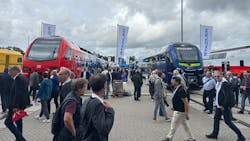What can the U.S. passenger rail industry learn from Asia and Europe?
The U.S. needs to think bigger when it comes to integrating commuter rail.
Representatives of the U.S. rail industry recently attended InnoTrans, the largest railway industry exhibition in the world. Held in Berlin every two years, the trade fair hosted around 170,000 people from 133 countries. Attendees marveled at everything, from a battery-hydrogen fuel cell locomotive to artificial intelligence (AI) algorithms for timetables to anti-graffiti film for glass.
For American attendees, InnoTrans is an opportunity to check in on the innovations happening in other parts of the world — especially the ability of Asian and European peers to integrate commuter rail into the lives of their passengers. Shortly after InnoTrans, U.S. railroad leaders gathered in Boston for the 2024 Commuter Rail Summit. There, attendees discussed the growing model of regional rail that serves more than just traditional nine to five commuters; transit-oriented development; and the latest technologies.
After having many conversations with members of the Commuter Rail Coalition, the biggest takeaway is that the U.S. needs to think bigger when it comes to making members’ rail dreams reality.
The prolific Chicago city planner and architect Daniel Burnham said it best:
“Make no little plans; they have no magic to stir men’s blood and probably themselves will not be realized. Make big plans; aim high in hope and work, remembering that a noble, logical diagram once recorded will never die, but long after we are gone will be a living thing, asserting itself with ever-growing insistency.”
The U.S. is decades behind other countries and must do more than just play catch-up. The industry will need ambition that matches the scale of the challenges.
Where Asia and Europe are thriving
Before traveling to Berlin, Michael Noland, president of the Chicago metro area’s South Shore Line, had heard InnoTrans was huge but that didn’t do the size of the event justice. Noland wants U.S. commuter rail leaders to dream that big.
“If we think small, we will stay small,” Noland said. “This will be a disservice to our riders and our stakeholders.”
Noland is now updating his railroad’s 20-year strategic vision with big, out-of-the-box thinking and a vision for a truly robust commuter system. He noted the rest of the world understands the importance of commuter and passenger rail, and the U.S. needs to catch up.
There are obstacles in the way, of course. David Harris, executive director of Modal Programs at the New Mexico Department of Transportation, points to the differences in geography, urban density and political environments between the U.S. and its overseas counterparts. American rail leaders should aspire to achieve the same integration of commuter rail into citizens’ daily lives and press for the cultural change necessary for the U.S. to tie together rail, bus, active transportation, services and businesses. The end goal is to create high-quality livable communities and vibrant mobility hubs.
“It’s our responsibility to press political will and financial resources to create this imaginable future,” Harris said.
Making that happen will involve revamping existing rail service — focusing on frequent service that arrives on time at low fares — so rail becomes a reliable part of people’s lives. Then significant public investment is needed in rail infrastructure, mixed-use development around train stations and public-private partnerships that promote the development of high-speed rail.
During the Commuter Rail Summit, attendees toured the air rights project under construction at Boston’s South Station, where a mixed-use tower with office and residential space is rising above the renovated rail and bus terminals. Dave Dech, executive director of the South Florida Regional Transportation Authority, pointed out the similarities between the project and many of the large train stations in Germany.
“We have opportunities, even if they are few, to intertwine our rail stations with the daily lives of our passengers, whether that be through transit-oriented development or thinking about our stations more like a community hub than a train station, offering amenities that will draw passengers and businesses to our respective properties,” Dech said.
Practical steps for rail projects
Looking back, while the U.S. was embracing the automobile culture and abandoning its rail infrastructure, Europe and Asia were building. Road congestion, climate impacts and the rising costs of car ownership stemmed that tide, but the U.S. is still decades behind the rest of the world.
Yet, there are reasons to be optimistic. Brightline opened the nation’s first private intercity passenger service in a century between Miami and Orlando and broke ground on a $12 billion service between Las Vegas and Southern California. In Texas, Amtrak has taken over a project to connect Dallas and Houston with a high-speed rail line, and several other states are actively planning new rail projects.
A recent report from New York University’s Transit Costs Project offered several recommendations for how the U.S. can improve the delivery of rail projects, including the introduction of high-speed rail. Above all else, the researchers said support at the national level — from Congress to the U.S. Department of Transportation — will be crucial in bringing new services to life.
Other best practices include standardizing technical standards and equipment, rather than letting each state choose its own rolling stock. Particularly in the case of high-speed rail, individual projects should plan to eventually coalesce into a national network. They also recommend streamlining the permitting process, bolstering the technical workforce with specialized skills and building up in-house expertise, so agencies don’t have to rely on expensive consultants.
These practical steps will all help the U.S. follow Asia and Europe’s lead in creating commuter rail networks that integrate seamlessly with their passenger’s daily lives, but the first step in the process is aiming high enough, as U.S. rail leaders, to begin with. It’s time to make big plans.
About the Author

KellyAnne Gallagher
CEO, Commuter Rail Coalition
KellyAnne Gallagher is CEO of the Commuter Rail Coalition. The coalition is an association of commuter rail agencies, operators and other interested parties acting together to engage and educate stakeholders on the value commuter railroads bring to the communities they serve.
Gallagher has transit and passenger rail experience through past positions with the American Public Transportation Association and New York Metropolitan Transportation Authority; she is also a a credentialed association exectuive.
